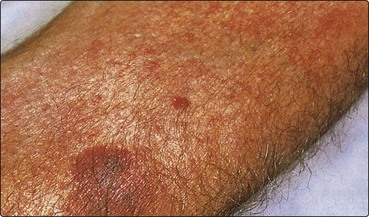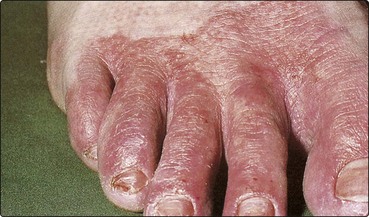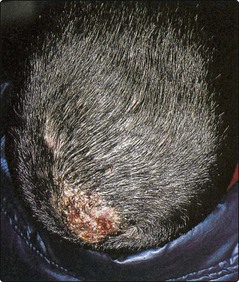New trends in dermatological treatment
Therapeutic advances have revolutionized the treatment of skin disease over the last 40 years. The 1960s saw the introduction of topical steroids, the 1970s the development of psoralen with ultraviolet A (PUVA), the 1980s retinoids, and the 1990s lasers and ciclosporin. The major advance of the ‘noughties’ was the biologics.
Atopic eczema
The topical immunomodulators (calcineurin inhibitors) tacrolimus (Protopic) and pimecrolimus (Elidel) are alternatives to topical steroids and do not cause skin atrophy (Fig. 1). The systemic immunosuppressors mycophenolate mofetil and methotrexate (the latter often used in psoriasis) may be beneficial in severe atopic eczema.
Bullous diseases
Intravenous immunoglobulin is used for severe pemphigus or mucous membrane pemphigoid. The biologic rituximab has been used in resistant cases (p. 33). Oral doxycycline may be effective in pemphigoid.
Cutaneous T cell lymphoma
The retinoid receptor agonist bexarotene (Targretin) is effective in some patients with cutaneous T cell lymphoma. Photophoresis, in which a lymphocyte-enriched blood fraction from the patient who has taken a psoralen is exposed to UVA outside the body and then re-infused, is sometimes effective, especially for the Sézary syndrome (p. 44).
Fungal infections
Terbinafine (Lamisil) cream, applied once or twice daily for 1 week, cures tinea pedis (Fig. 2). Pulse treatment with oral itraconazole (Sporanox), terbinafine (Lamisil) or fluconazole (Diflucan) has given cure rates of 80% for fungal infection of the toenails. Three-weekly pulses of terbinafine (Lamisil) given over 8 weeks produce a 90% cure rate for childhood tinea capitis (Fig. 3).
Stay updated, free articles. Join our Telegram channel

Full access? Get Clinical Tree





